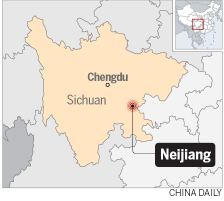18 injured as quake shakes Sichuan

A magnitude 5.2 earthquake jolted Zizhong, a county under the administration of Neijiang city in Sichuan province, at 8:14 am on Wednesday.
As of press time on Wednesday, 18 people had been wounded. Sixteen of them, including five with serious injuries, were hospitalized, while the other two returned home after medical treatment for minor injuries. Ten houses collapsed and nearly 800 were damaged with economic losses surpassing 11.4 million yuan ($1.63 million), according to the Neijiang government information office.
The city of Neijiang dispatched 6,107 people in a search and rescue operation, which concluded on Wednesday. Five hundred cotton quilts and 500 cotton coats were sent to the quake zone.
The epicenter of the quake was in Chenjia town in Zizhong, about 152 kilometers from the Sichuan provincial capital Chengdu.
Still, many residents in the area felt the quake.
Wei Lai was sleeping on the fifth floor of an apartment in downtown Chengdu, when he was awakened by the shaking of his bed.
"I thought the shaking would be over immediately. But in less than 10 minutes, the bed and windows shook twice," he said. "I was scared and jumped out of bed."
Thirty-five seconds before seismic waves reached Chengdu, a real-time system provided early warnings to Chengdu residents.
The system can save lives because the warnings are transmitted via radio waves traveling faster than seismic waves.
Radio waves travel at 300,000 kilometers per second, while seismic waves travel at 3 to 6 km/s. Therefore, people in nearby areas may escape before seismic waves arrive, said Chen Huizhong, a senior research fellow with the Institute of Geophysics under the China Earthquake Administration.
China started attaching importance to early warnings after the Wenchuan quake in 2008, he said.
Following that temblor, Wang Tun, a postdoctoral fellow of theoretical physics at the Austrian Academy of Sciences, set up the Institute of Care-Life in Chengdu to study the early warning system.
His institute has sent correct early warnings after many quakes, including the magnitude 7.0 earthquake in Lushan, Sichuan, in 2013; the magnitude 6.5 earthquake in Ludian, Yunnan province, in 2014; and magnitude 7.0 earthquake in Jiuzhaigou, Sichuan, in 2017.

Today's Top News
- Namibian FM highlights China's role in progress
- Policy effort to bolster growth bears fruit
- Xizang's first guide dog helps his owner break barriers
- Thai court suspends PM over leaked call
- Xi stresses building unified national market, promoting marine economy's high-quality development
- A tale of two intellectual paradigms






























